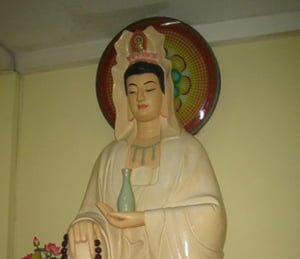The basic act of Buddhist devotion is taking refuge in the Three Jewels: Buddha, Dharma and Sangha.
 |
| Monks at Tinh Xa Trung Tam, Saigon |
The Buddha is the person of the most enlightened one, the Dharma is the body of the Buddha's teachings - but what is the Sangha?
 |
| Buddha shrine at Vien Giac Temple, Bui Thi Xuan St, Tan Binh district, Ho Chi Minh City. |
Sangha is a Sanskrit and Pali word meaning "Assembly" or "Community." Traditionally the Sangha has been interpreted to mean the monastic community of dedicated religious practitioners living together in a community devoted to the Buddha's teachings.
But Vietnamese Buddhist teacher Thich Nhat Hanh has taken the concept further. In his book Joyfully Together: The Art of Building a Harmonious Community, he explains Sangha in this way:
"Any group of people can practice as a Sangha, as a community that is determined to live in harmony and awareness. All we have to do is commit ourselves to going together in the direction of peace, joy, and freedom. Together, we benefit from each other's strengths and learn from each other's weaknesses. A family is a Sangha, the members of a monastic and lay practice centre are a Sangha; even the United Nations is a Sangha! A Sangha is a family, a spiritual family connected by the pactices of mindfulness, concentration, and insight. The Sangha may be Buddhist, or even non-Buddhist, so long as it is a community that walks the path of liberation together."
These days the Sangha is normally spoken of as "the community that follows the Dharma," thereby incorporating all Buddhists, lay and monastic.


No comments:
Post a Comment